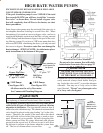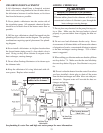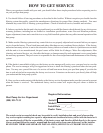
25
SHUT DOWN & FREEZE PROTECTION PROCEDURES
When shutting the unit down for the end of the swimming season, you must consider some items to protect the unit
from inclement weather. It is best in most situations to shut the unit off by turning the thermostat all the way
down, to the "left". Leave power (circuit breaker), to the unit “on” unless the pool or spa water temperature
drops below 50 degrees F.
SHORT TERM FREEZE PROTECTION PROCEDURES
When the outside air temperature is forecast to drop below 32 degrees F for a short time:
You should set the circulation pump timer to run 24 hours per day in order to circulate water through the unit and
filtration system. Standing water inside the piping will freeze and damage the water heat exchanger and refriger-
ant system. Shut the heat pump off and do not try to heat the pool during freezing temperatures. If the unit is left
running it may ice up and the compressor will stop running. The defrost control inside the unit will shut the
compressor off, but allow the fan to run. The fan will circulate air through the unit to help defrost the evaporator
air coil. If you know that the temperatures are going to be below 36 degrees F, you should eliminate the possibil-
ity of icing and just shut the unit off. Do not use the circuit breaker as the “on/off” switch, if you want to shut down
for a long period of time use the disconnect. (See page 27)
LONG TERM FREEZE PROTECTION / DRAIN VALVE INSTALLATION
If you live in a climate that has a seasonal swim season due to winter, you should follow these
long term freezing procedures.
If you live in an area that experiences freezing temperatures,
the heat exchanger/water coil and bypass plumbing must
have all water removed to prevent freeze and chemical dam-
age to the heat pump system. This procedure should be done
prior to the first freeze along with your other pool winteriz-
ing routine. When you drain the filter system and piping you
should include the heat pump as well.
There should be two spigot type drains, (hose bibbs),
plumbed into the heater's water in and water out piping. Place
these valves as close to the heater and at the lowest point
possible so as much water will drain as possible. Install two
shut off valves on the water in and out lines as shown here.
The rest of the water should be blown out with pressurized
air to insure all water is removed. A antifreeze designed for
pool equipment may be used, see a local pool professional.
Spigot Type
Drain Valves
(Hose bibb)
Shut the water pump off. Close both shut off
valves. Open both drains and allow water to
exit. Use pressurized air on the water in, one
spigot only, to force the rest of the water out
the other spigot.
IN
OUT
2-way
Shut Off
Valves
CAUTION
Do not add isolation valves unless you
intend to clear the heat exchanger of
water with pressurized air! Stagnant
water left in the heat exchanger can
cause corrosion and will freeze causing
damage!
!


















